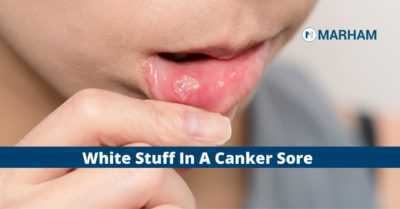Canker sores are a type of mouth sore. Although they are not contagious, they can be irritating and painful. Stress, acidic foods, and minor injuries to the inside of your mouth are all causes of canker sores. Over-the-counter or prescription gels, ointments, and rinses are examples of treatments. Canker sores usually heal in two weeks even without treatment. But have you wondered what is the white stuff in a canker sore? Here is the answer!
Canker sores, also known as aphthous ulcers, are small, shallow lesions that form on the soft tissues of the mouth or at the base of the gums. Canker sores, unlike cold sores, do not appear on the surface of your lips. They can, however, be painful and make eating and talking difficult.
Some people notice them between their lips or on their cheeks. They’re usually white or yellow, with red, inflamed soft tissue surrounding them. A layer of white stuff in the canker sore is common in the later stages of a canker sore. So, what exactly is this white substance in a canker sore, and why does it form?
Read More About Mouth Ulcers, Symptoms, Causes and Treatment Over Here!
What is the White Stuff in a Canker Sore?
The white stuff you see in your canker sore or mouth ulcer is dead tissue and bacteria residue. Slough is the scientific term for this white substance. It sticks to the wound bed and is made up of dead cells that have accumulated in the wound.
The residue from dead tissue and bacteria that you frequently see in your canker sore or mouth ulcer is white. This white substance is referred to as slough in science. It clings to the wound bed and is made up of dead cells that build up in the wound.
How to Treat Canker Sore?
Usually, canker sores disappear on their own. You can, however, make a lot of beneficial lifestyle adjustments to treat canker sores.
Bacteria thrive in the canker sore’s environment and the “white stuff” that is present there. In order to hasten the healing of the canker sore, it is crucial to prevent the growth of bacteria. For best results, use mouthwash that contains peroxide or a saltwater rinse. To encourage healing, it is essential to keep the outbreak site free of bacteria.
For instance, avoiding spicy foods will hasten the healing process while regularly brushing and flossing your teeth will help prevent a bacterial infection.
This white stuff will typically clear up on its own. However, studies have shown that the white substance in a canker sore actually slows the healing process by infecting the sore again.
A debridement agent can frequently be useful to prevent this and hasten the healing process. One of the best debridement products in the market has alum and lysine among other ingredients to cauterize the canker sore first before accelerating the healing process.
منہ کے چھالوں کا علاج ہم گھر میں کن 5طریقوں کی مدد سے کرسکتے ہیں جانیں
What are the Symptoms of Canker Sore?
Some of the common symptoms of minor canker sore are;
- a tingling or burning sensation pain when speaking, eating, or drinking
- small, oval-shaped bumps inside the mouth
Major canker sores show symptoms like;
- Significant pain that makes it difficult to speak or eat
- large, rounded bumps inside the mouth that are tingly, burning, or inflamed
The majority of canker sores have a red border and a round or oval shape with a white or yellow center. They develop inside your mouth, either on your soft palate or on or under your tongue, inside your cheeks or lips, or at the base of your gums. A day or two before the sores actually appear, you might feel tingling or burning. There are many over-the-counter medications that can treat canker sore symptoms, such as rinses and topical ointments.
Make an appointment with your healthcare provider if your canker sores are unusually large or if your symptoms are affecting your daily life.
| Android | IOS |
|---|---|
 |
 |
FAQs
Is it normal for a canker sore to pop?
Aphthous ulcers, also known as canker sores, only develop inside the mouth. They can appear on or under the tongue, as well as on the inside of the cheeks and lips, which are the moving parts of the mouth. They typically appear alone, but occasionally they do so in small groups.
Does hydrogen peroxide get rid of canker sores?
By cleaning the sore and reducing oral bacteria, hydrogen peroxide aids in the healing of a canker sore. To use: Mix equal parts water and a hydrogen peroxide solution at a concentration of 3%.

